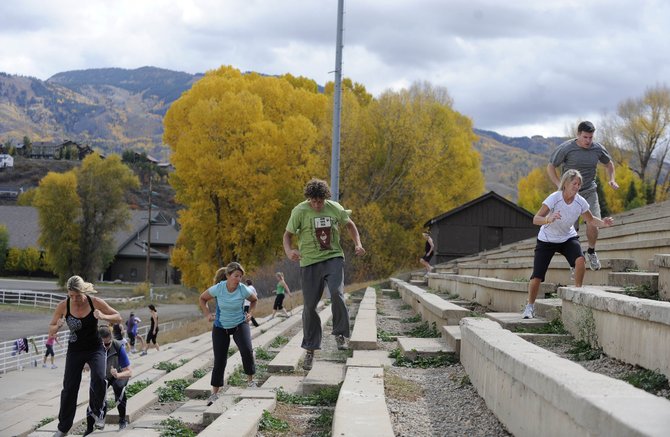In anatomy 101 you learn that there are three main types of skeletal muscular contractions.
Isometric, Concentric, and Eccentric. I feel that you should train all three if you want to get the most out of your training.
 |
| Using Arm curls as an example |
Think about climbing stairs. Up the stairs is primarly concentric muscle contractions.
 |
| I doubt if he is saying to himself, only 5 more flights on concentric climbing left. |
Now think about descending stairs. Make sure you have enough eccentric strength to control your body on the way down. Imagine your body is this truck.
 |
| Descending stairs. I sure hope the brakes don't fail. |
Take Squatting as another example. As you lower your body you are performing Eccentric work; if you pause anytime during the lift, the muscles being used to hold the position are being used isometrically; as you raise your body you are performing the concentric portion of the lift.
Ask the average person what the purpose of their skeletal muscular system is and you will probably hear answers such as:
To make you move, jump, run, lift things, throw things, etc. This is why most people and trainers focus on training their muscles to make the body move? It is also easier to get an idea of how much work you accomplish during concentric contractions. (Ex. You lifted 100#'s 10 times)
What do these all have in common?
They all involve
concentric muscle contractions.Think of concentric contractions as the engine in the body. They determine how the body moves.
What do I think is the most under trained type of muscle contraction?
Eccentric contractions.
Why? When strength training most people focus on how much weight they can lift. They rarely focus on how to control the weight while is is being brought back down to the starting position of the lift. One of the reasons is we don't measure how much work is done during the eccentric parts of a set. (Ex. You spent 45 seconds of that last set on the eccentric portion of the lifting)
Think of eccentric training as teaching the mind how to stop movements. Would you want to drive your car without brakes. Shouldn't you learn how to stop your body when you need to?
In 2010 I was attending the Missouri Strength & Conditioning Seminar at Parkway North. One of the speakers was Dana LeDuc. (the Strength & Conditioning Coach of the St. Louis Rams at the time) During his presentation he mentioned that the rams players used eccentric lifting during leg curls to prevent hamstring injuries. When he was done speaking I got to ask him a question.
Where there any other lifts being used eccentrically to prevent injuries? He said no. Too much Eccentric training can slow an athlete down.
If one of the best Strength & Conditioning Coaches in the world doesn't focus much on Eccentric lifting is it any surprise that most people don't?
Why do I feel that you should focus more on the eccentric part of the lift?
1. It strengthens connective tissue (ligaments and tendons) more than Concentric lifting. Stronger connective tissue is less likely to get injured. I would be willing to bet that if more emphasis was put on the eccentric parts of lifting, there would be a lot less injuries in all levels of sports.
2. It teaches your mind how to control movements better leading to greater balance and less chance of falling down.
3. It leads to better change of direction and agility. (athletes focus on this while everyone should.)
4. It is a great way to get stronger in less time. (More bang for your buck)
What is the biggest risk of Eccentric training? It can make your muscles really sore when too much of it is done.
What type of contractions are being used to control proper posture while lifting/moving? Isometric Contractions. While performing a movement like a squat, isometric contractions stabilize the torso. You wouldn't want your torso moving all over the place while squatting. Even if you think you never perform isometrics, you perform them all the time.
 |
| Imagine the amount of isometric work being done during this picture. |
I was watching a performance of my daughter's Cheerleading team on video
recently and was amazed at the amount of isometric work being done by the bases and flyers during their stunts. Getting really strong doing the standing press and overhead squats would pay off the the bases. The flyers could reap huge benefits from working on single foot stability.










